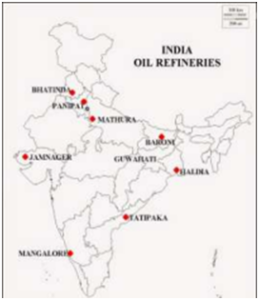Ethics Theory, TLP-UPSC Mains Answer Writing
Q. 1. Petroleum refineries in developing countries like India are often located away from crude oil-producing regions. Examine the geographical and economic factors responsible for such spatial patterns. (150 words, 10 marks)
Introduction
In developing nations, petroleum refineries are often located away from oil fields and instead near coasts, cities, or industrial hubs, aligning more with economic and logistical priorities than proximity to crude oil sources.
Body
Geographical Factors Responsible
- Proximity to Ports: Refineries are often set up near coastal areas to facilitate crude oil imports and petroleum product exports. Example: Jamnagar refinery in Gujarat is close to ports despite India importing over 80% of its crude oil.
- Accessibility to Markets: Refineries are located near consumption hubs to reduce transportation costs of refined products. Example: Mathura refinery is closer to Delhi NCR, a major fuel consumption zone.
- Availability of Land and Water: Large flat land and water supply are necessary for refinery operations, often more available away from resource-rich regions. Example: Paradip refinery in Odisha is situated on the coast for water and space requirements.
- Environmental and Safety Considerations: Refineries are kept away from populated areas and ecologically sensitive zones for safety and compliance. Example: Refineries in remote belts of Assam and Odisha have controlled buffer zones.

Economic Factors Responsible
- Demand-Centric Planning: Refineries cater to urban-industrial centres to serve growing domestic fuel demand more efficiently. Example: Chennai and Mumbai refineries serve densely industrialised belts.
- Infrastructure and Connectivity: Better road, rail, and port infrastructure in certain non producing regions supports refined product distribution. Example: Bina refinery in Madhya Pradesh leverages central location and logistics.
- Export Orientation and SEZ Policies: Coastal refineries benefit from Special Economic Zone (SEZ) advantages and tax incentives for exports. Example: Reliance’s Jamnagar refinery is the world’s largest export-oriented refinery.
- Crude Supply Diversification: Countries importing multiple grades of crude prefer refining near ports to handle varied logistics, not near single-source production zones. Example: Most African and Southeast Asian countries locate refineries near coasts for flexible crude sourcing.
Conclusion














